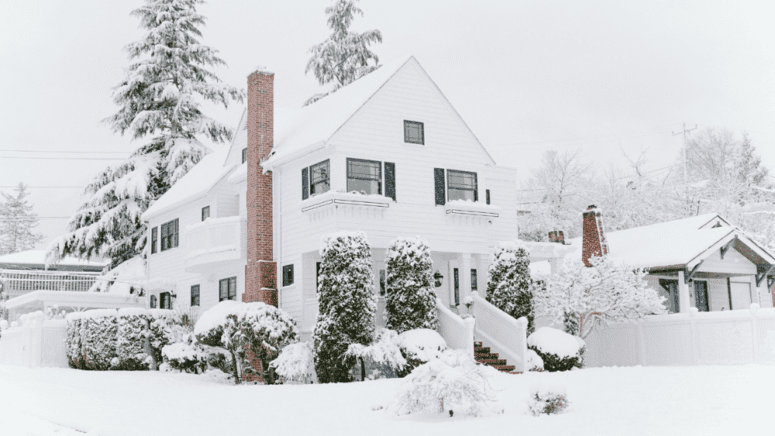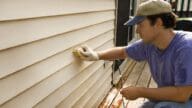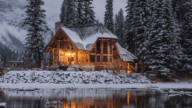13 Winter Energy Saving Tips to Reduce Your Bills
- Published on
- 12 min read
-
 Melissa Rudy, Contributing AuthorClose
Melissa Rudy, Contributing AuthorClose Melissa Rudy Contributing Author
Melissa Rudy Contributing AuthorMelissa Rudy is a seasoned digital journalist with 15 years of experience writing web copy, blog posts and articles for a broad range of companies. When she can’t buy or sell homes, she settles for the next-best thing: researching and writing about all things real estate-related.
-
 Jedda Fernandez, Associate EditorClose
Jedda Fernandez, Associate EditorClose Jedda Fernandez Associate Editor
Jedda Fernandez Associate EditorJedda Fernandez is an associate editor for HomeLight's Resource Centers with more than five years of editorial experience in the real estate industry.
Searching for some winter energy saving tips? You’re smart to think ahead. For homeowners who live in multi-season climates, there’s plenty to love about fall. But just a few weeks beyond all of that fiery foliage and crisp autumn air, the cold winter months are looming — along with some not-so-enjoyable elements.
You know the culprits: high heating bills, drafty windows, and a water tank that’s tough to keep warm.
These winter energy saving tips can help
Top real estate agent Laura Snyder sells homes in Harford County, Maryland, where winter brings cold, snowy weather with low temperatures in the 20-degree range. She’s fielding more questions about energy efficiency these days, as buyers tighten budgets and look to reduce their monthly bills. In many cases, homeowners even hand over their pared-down utility bills for their agents to use as a selling point.
While you can’t control Mother Nature, you can take action to get your house ready for her wrath and make the home as comfortable and efficient as possible with these 7 winter energy saving tips. Here’s where you should focus your efforts, according to experts we spoke with in the energy industry.
Start with an energy audit
A home energy assessment, or home energy audit, is a method to systematically analyze all aspects of your home’s energy use. While a professional audit will give you the most accurate idea of where your home could use some efficiency improvements, you can also perform a DIY version yourself. A professional auditor will use technology including infrared cameras, furnace efficiency meters, and surface thermometers to give you a room-by-room accounting of where your home is losing heat. The Residential Energy Services Network has a directory to help you find a professional auditor in your area.
While your home’s areas of improvement will be specific to your house, here are the top actions homeowners can take for winter energy saving:
1. Upgrade your windows
Windows are one of the most critical drivers of a home’s energy efficiency (or lack thereof). According to the Department of Energy, heat escaping and coming in through windows is responsible for up to 30% of residential heating and cooling usage.
Energy-efficient, dual-pane windows are designed to keep cool air inside during hot summer months and trap heat inside during the winter. Most are made from synthetic materials like vinyl, with two panes of glass and Argon gas to boost efficiency.
When shopping for windows, look at the U-factor rating, which is a measure of how well a window insulates. The U-factor for windows typically ranges from 0.20 to 1.20, with the lower numbers indicating better insulation.
Michael DiMartino, senior vice president of installations at Power Home Remodeling, recommends a rating of .30 or lower. Another factor to consider is whether the glass is coated with low-E, an invisible metallic layer that reflects UV rays and further increases insulation.
Also check to make sure the windows are ENERGY-STAR-certified (which indicates the product’s energy efficiency) and that they have an NFRC label (which allows you to compare the energy performance ratings of different windows across four different categories).
Top energy-efficient windows
Each year, ENERGY STAR selects the windows with the best energy-efficiency ratings. Below are some of this year’s best options with U-factor ratings of .20 or less:
- Alpen Fiberglass Picture Windows
- Innotech Vinyl Picture Windows
- Innotech Vinyl Dual Action Windows
- OKNA Vinyl Picture Windows
2. Get your existing windows winter-ready
If springing for new windows isn’t an option, there are some ways to winterize your existing windows. Here are a few cost-effective winter energy saving tips to consider for your windows:
Add insulating window coverings
Hang curtains or drapes to help preserve heat. The thicker the curtain, the more insulation it provides. The Department of Energy estimates that when drawn closed during the cold winter months, most conventional draperies can reduce heat loss by up to 10%.
Some of the top-rated insulating curtains include:
- Solid Blackout Thermal Grommet Curtain Panels from Wayfair
- Aurora Home Solid Insulated Thermal Blackout Curtain Panels from Overstock
- Sun Zero Energy-Efficient Curtains from Amazon
“Drapes with light-colored material facing out will reflect more sunlight in a way that keeps the room cool on hot days,” notes Mark Dawson, COO of One Hour Heating & Air Conditioning. “Because of this, during the winter it’s best to use drapes with dark-colored material to have the reverse effect.”
In addition to curtains, the use of shades, blinds, and some types of shutters can help to keep heat from escaping through windows. As with the curtains, look for reversible designs with light coloring on one side and dark on the other.
Get a window insulation kit
Another budget-friendly option is to cover the windows and sliding doors with an insulating plastic film. Marc Brener, B.S., director of energy efficiency for Energy Experts International, says this can help save up to 15% on your winter energy bill.
Most hardware stores carry window insulation kits. “These are just plastic sheets that adhere to your window to plug any gaps that can be found between the window and the sill,” says Matthias Alleckna, an energy analyst at EnergyRates.ca. “This prevents any heat loss from air leakage, but also prevents the cold glass from cooling the room temperature.”
3. Amp up your attic insulation
DiMartino cites this as one of the most effective ways to winterize a home, helping to retain heat and lower the energy bill. “Pay attention to the attic’s insulation R-value (thermal resistance),” he says. “Anything under R-38 could be considered under-insulated, but check your building code for more specific insulation requirements.”
According to the Department of Energy, the R-value measures the type of insulation, its thickness, and its density. The higher the number, the better the insulating properties. Generally speaking, adding more insulation will increase the R-value. To determine whether your home needs more insulation, consult with a specialist in your area.
Andy Kolodgie, co-owner of The House Guys, a D.C.-based property investment company, often adds insulation to his rental homes to increase energy efficiency. He says a common oversight is focusing on the main attic space, but neglecting the doorway/opening to the attic. “Having that nine-square-foot area insulated is one of the first things we do to our rentals,” he says.
You can always hire an insulation contractor to beef up your attic insulation, or if you’re the hands-on type, you can save some money by tackling it as a DIY project.
4. Find and fix any leaks
With as much as one-third of a home’s heat escaping through drafty windows and doors, it’s important to pinpoint and plug any leaks before the cold winter air finds them first.
The most cost-effective way to find leaks is to look for them yourself. Closely examine the doors, windows, baseboards, and any other places where small cracks or gaps can form in your home’s foundation.
“If you can see sunlight peeking through cracks around window frames or where your door meets your wall, that means air is also able to pass through, and you need to seal those areas,” says DiMartino.
Other often-overlooked sources of leaks are the areas where vents are installed, such as the clothes dryer, as well as chimneys. For complete peace of mind, a certified energy auditor can perform an infrared energy audit, which will detect all of the areas where air is leaking.
If you encounter any gaps or cracks, weatherstripping and caulking are common and easy ways to seal the area. According to the Department of Energy, weatherstripping is used to seal moving components, such as doors and windows, while caulking is used to seal up any openings or cracks between door frames, window frames, and other non-moving parts of the house. (Pro tip: Snyder notes that you may be able to get a money-back rebate from your energy provider after making the fixes.)
If you’re a handy homeowner, you can save some money by addressing air leaks yourself. Brad Roberson, brand president of Glass Doctor, a Neighborly company, offers these steps for DIY caulking:
- Choose a caulking product that comes in a disposable cartridge and fits in a caulk gun with an automatic release for easy application. Wait until it’s above 45 degrees outside to apply caulk.
- Remove any existing cracked caulk with a putty knife or screwdriver. Clean and dry the area to ensure good adhesion.
- Apply the caulk at a 45-degree angle to help the substance seep deep into the crack. Apply in one continuous stream. If caulk oozes out of the crack, use a putty knife or your moistened finger to smooth it out.
If you’re not comfortable doing your own caulking, you can hire a handyman or contractor.
5. Invest in a smart thermostat
According to the Department of Energy, setting your thermostat back by 7°-10°F for eight hours a day can save up to 10% each year on heating and cooling costs — but it can be difficult to remember to turn it down before going to bed or leaving the house.
Enter smart thermostats. These Wi-Fi enabled systems learn your habits and temperature preferences. They automatically adjust the settings to create the most comfortable environment while you’re at home, and conserve energy while you’re asleep or away from home.
One of the most popular options on the market is Google’s Nest Learning Thermostat, which runs around $280. Homeowners can control the system from an app on their smartphones, lowering the temperature if they’re going to be away for an extended period.
Snyder notes that smart thermostats have become a selling point in the eyes of homebuyers. In addition to controlling a home’s temperature, Nest systems can also be programmed to lock and unlock doors. For this reason, some sellers are choosing to use them as a replacement for the traditional lock box, which also serves to showcase their smart systems as a selling point.
6. Service your HVAC system regularly
Experts recommend tuning up the furnace at least once a year, ideally before the heating season begins. According to Dawson, annual tune-ups can add years to the lifespan of your furnace.
“The average furnace will need replacement after about 15 years, but if you take very good care of it and stay diligent about tune-ups, it may last for more than 20 years,” he notes.
Elements of a furnace tune-up include several checks and adjustments that make a big difference in your furnace’s efficiency. A tune-up also makes it possible to catch and repair small problems before they turn into big, expensive ordeals.
In between tune-ups, remember to change your furnace filter regularly — every month, or as recommended by the manufacturer — to help winterize your home and allow for proper flow of warm air.
“When your furnace is blasting hot air but it can’t get past the dirty filter, all the warm air will stay near the furnace, leaving your house cool and your furnace bill high,” explains Kolodgie of The House Guys.
7. Show your water heater some winter love
There’s nothing like a hot shower on a cold winter day — but keep in mind that your water heater accounts for up to 18% of your electric bill. Lowering the water heater temperature to 120°F (49°C) will save on energy costs while ensuring sufficient hot water for household needs.
To help your water heater operate more efficiently, Doyle James, president of Mr. Rooter Plumbing, recommends insulating the unit to reduce lost heat by 25%-40%, which will reduce utility bills.
“An insulation jacket will help prevent major heat loss at the unit, while pipe insulation will preserve the heat as water moves from the water heater tank to faucet,” he explains.
If you have an older system, James recommends flushing sediment from the unit for an efficiency boost. “Sediment causes corrosion, reduces efficiency, and shortens your water heater’s life span,” he says.
If your water heater is 15-20 years old, the greatest energy savings comes from replacing it with a new unit. Snyder sees a lot of homeowners opting for tankless water heaters, which heat up the water on-demand as needed for greater efficiency.
8. Utilize ceiling fans in reverse mode
They’re not just for summertime. Dawson explains that for most ceiling fans, you can flip the directional switch so that the blades turn clockwise. Then, run the fans on low speed in occupied rooms to create an updraft. This method will gently circulate the warmest air, which congregates near the ceiling.
9. Seal unused rooms
Sealing unused rooms during the winter is a simple yet effective way to save energy and reduce heating costs. By closing doors and vents in areas of the home that are not frequently used, you can prevent warm air from being directed into these spaces. This allows your heating system to focus on warming the rooms that are actively occupied, enhancing overall energy efficiency.
Additionally, using draft stoppers or weather stripping around doors and windows in these unused areas can help prevent cold air from seeping into other parts of the house.
10. Clean vents and maintain heating systems
“Your heating system will function most effectively when there’s an unobstructed flow of air coming from your returns and vents,” says Dawson. “To ensure that it has a clear path, clean these vents routinely to remove any dust or other debris that may have settled.”
Check that vents are unobstructed to help them work more efficiently. “Your vents are like the vascular system of the house — and if you’ve got a couch sitting on top of one, or if they’re clogged up with dust, then the furnace air can’t circulate properly,” says Alleckna.
11. Lay down rugs on hardwood floors
DiMartino recommends this as an easy, efficient way to add an extra layer of insulation to your home and save money on your energy bill. “Not only do rugs help your feet stay warm, but they help trap cold air underneath and keep it from circulating around the room,” he notes.
12. Maximize heat from the sun during the day
When the sun is out, open up the curtains and blinds to let the warming rays into the room. After sundown, close them again to keep the heat inside.
13. Consider installing storm windows and doors
If you don’t have the budget for new windows, another option is to install storm windows over the existing single-pane glass, which can save around 10% on annual heating and cooling costs. “Storm windows will reduce unwanted air flow by sealing off drafts,” says Bob Wiseman, president of Canoga Park Heating and Air Conditioning. “You can remove them during warmer months so it’s easier to let in cool breezes and reinstall them as the weather begins to get colder.”
Winter presents its fair share of challenges to homeowners, but by following these winter energy saving tips, you can weather the cold season without freezing up your cash flow.
Header Image Source: (Tracy Adams / Unsplash)






